Destination Media Analysis: Budapest Pre-Trip Media Source Report
VerifiedAdded on 2023/01/12
|9
|1933
|51
Report
AI Summary
This report provides a comprehensive analysis of media sources used to promote Budapest as a travel destination. It examines both print media, specifically the Lonely Planet website, and audio-visual media, focusing on YouTube videos. The report delves into the purpose of these media sources, their target audiences (including tourists, couples, and business travelers), and the tone they adopt to influence perceptions of Budapest. It also explores the application of media theories, such as the uses and gratification theory for print media and the effects theory for audio-visual media, to understand how these sources engage with and impact their audiences. The report highlights the similarities and differences between print and audio-visual media, concluding that both are essential for effective destination marketing. It references various academic sources to support its analysis of pre-trip planning and destination image creation.
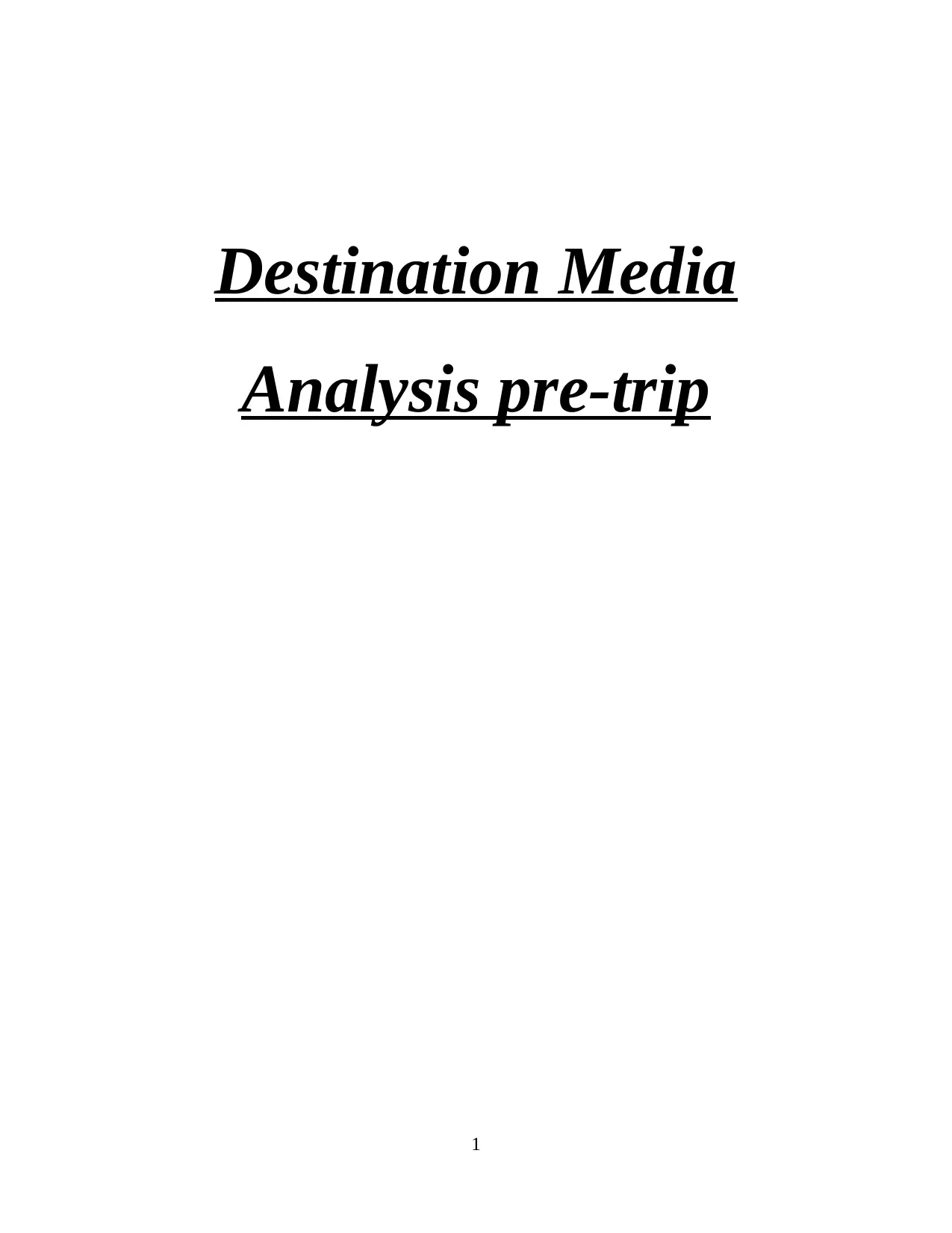
Destination Media
Analysis pre-trip
1
Analysis pre-trip
1
Paraphrase This Document
Need a fresh take? Get an instant paraphrase of this document with our AI Paraphraser
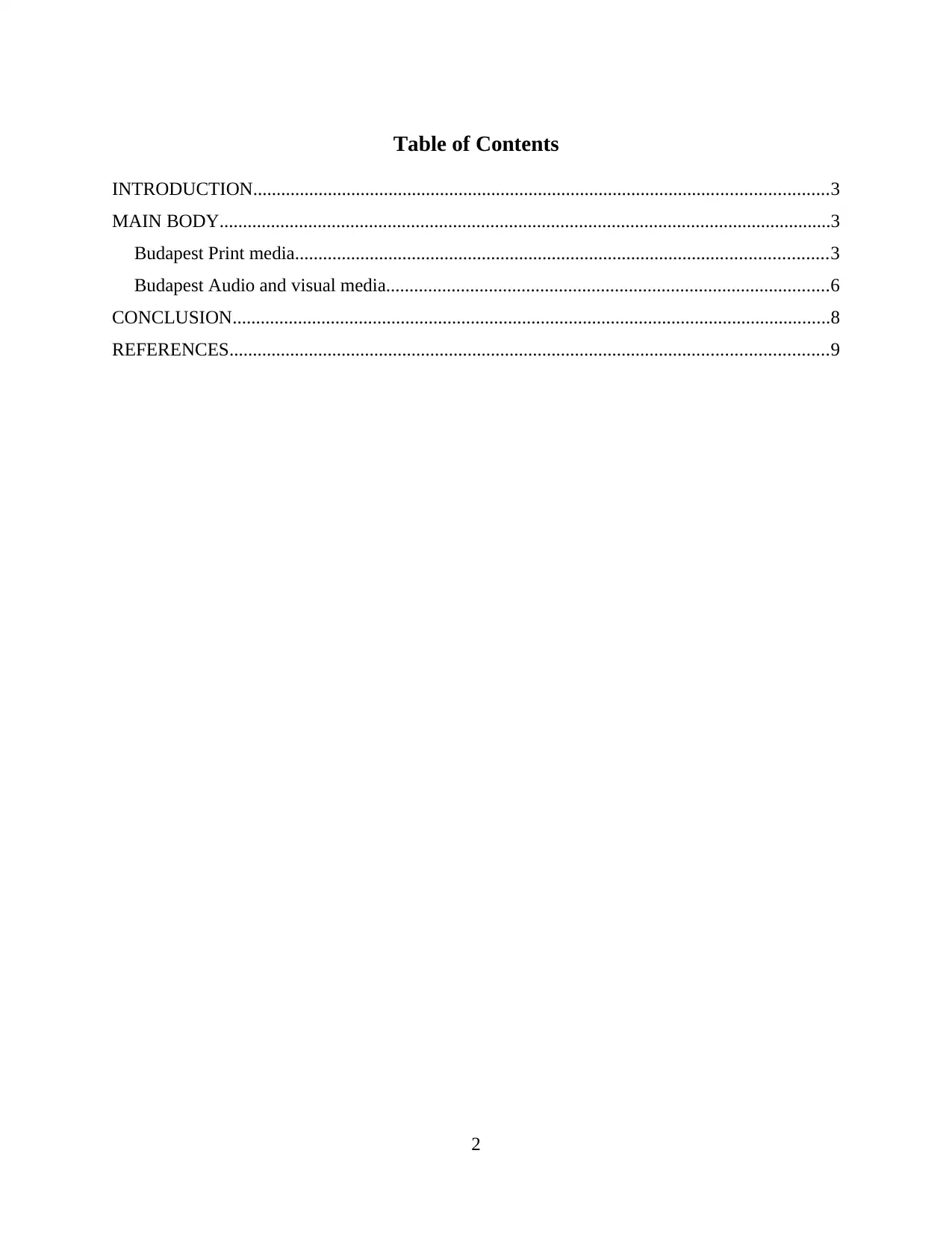
Table of Contents
INTRODUCTION...........................................................................................................................3
MAIN BODY...................................................................................................................................3
Budapest Print media..................................................................................................................3
Budapest Audio and visual media...............................................................................................6
CONCLUSION................................................................................................................................8
REFERENCES................................................................................................................................9
2
INTRODUCTION...........................................................................................................................3
MAIN BODY...................................................................................................................................3
Budapest Print media..................................................................................................................3
Budapest Audio and visual media...............................................................................................6
CONCLUSION................................................................................................................................8
REFERENCES................................................................................................................................9
2
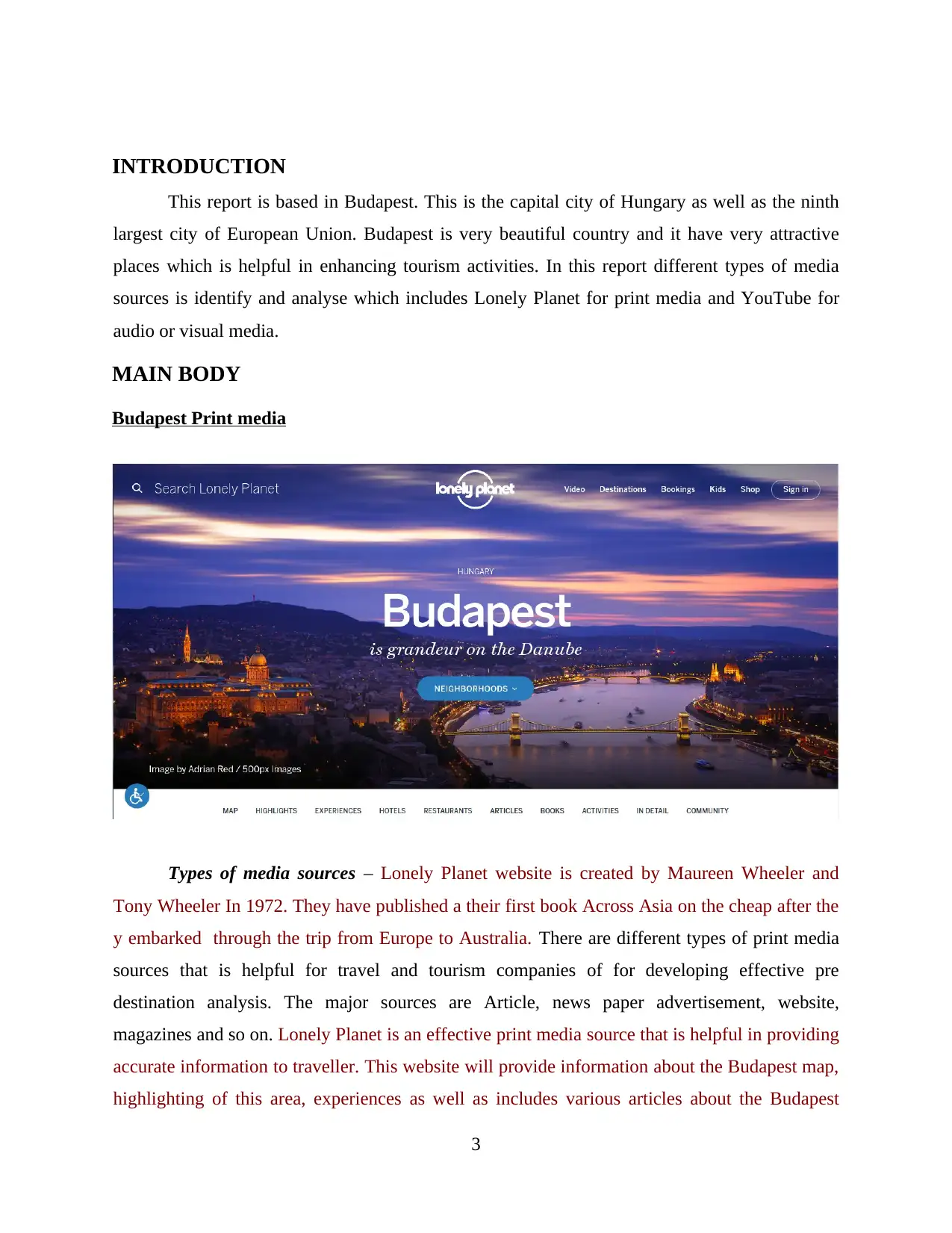
INTRODUCTION
This report is based in Budapest. This is the capital city of Hungary as well as the ninth
largest city of European Union. Budapest is very beautiful country and it have very attractive
places which is helpful in enhancing tourism activities. In this report different types of media
sources is identify and analyse which includes Lonely Planet for print media and YouTube for
audio or visual media.
MAIN BODY
Budapest Print media
Types of media sources – Lonely Planet website is created by Maureen Wheeler and
Tony Wheeler In 1972. They have published a their first book Across Asia on the cheap after the
y embarked through the trip from Europe to Australia. There are different types of print media
sources that is helpful for travel and tourism companies of for developing effective pre
destination analysis. The major sources are Article, news paper advertisement, website,
magazines and so on. Lonely Planet is an effective print media source that is helpful in providing
accurate information to traveller. This website will provide information about the Budapest map,
highlighting of this area, experiences as well as includes various articles about the Budapest
3
This report is based in Budapest. This is the capital city of Hungary as well as the ninth
largest city of European Union. Budapest is very beautiful country and it have very attractive
places which is helpful in enhancing tourism activities. In this report different types of media
sources is identify and analyse which includes Lonely Planet for print media and YouTube for
audio or visual media.
MAIN BODY
Budapest Print media
Types of media sources – Lonely Planet website is created by Maureen Wheeler and
Tony Wheeler In 1972. They have published a their first book Across Asia on the cheap after the
y embarked through the trip from Europe to Australia. There are different types of print media
sources that is helpful for travel and tourism companies of for developing effective pre
destination analysis. The major sources are Article, news paper advertisement, website,
magazines and so on. Lonely Planet is an effective print media source that is helpful in providing
accurate information to traveller. This website will provide information about the Budapest map,
highlighting of this area, experiences as well as includes various articles about the Budapest
3
⊘ This is a preview!⊘
Do you want full access?
Subscribe today to unlock all pages.

Trusted by 1+ million students worldwide
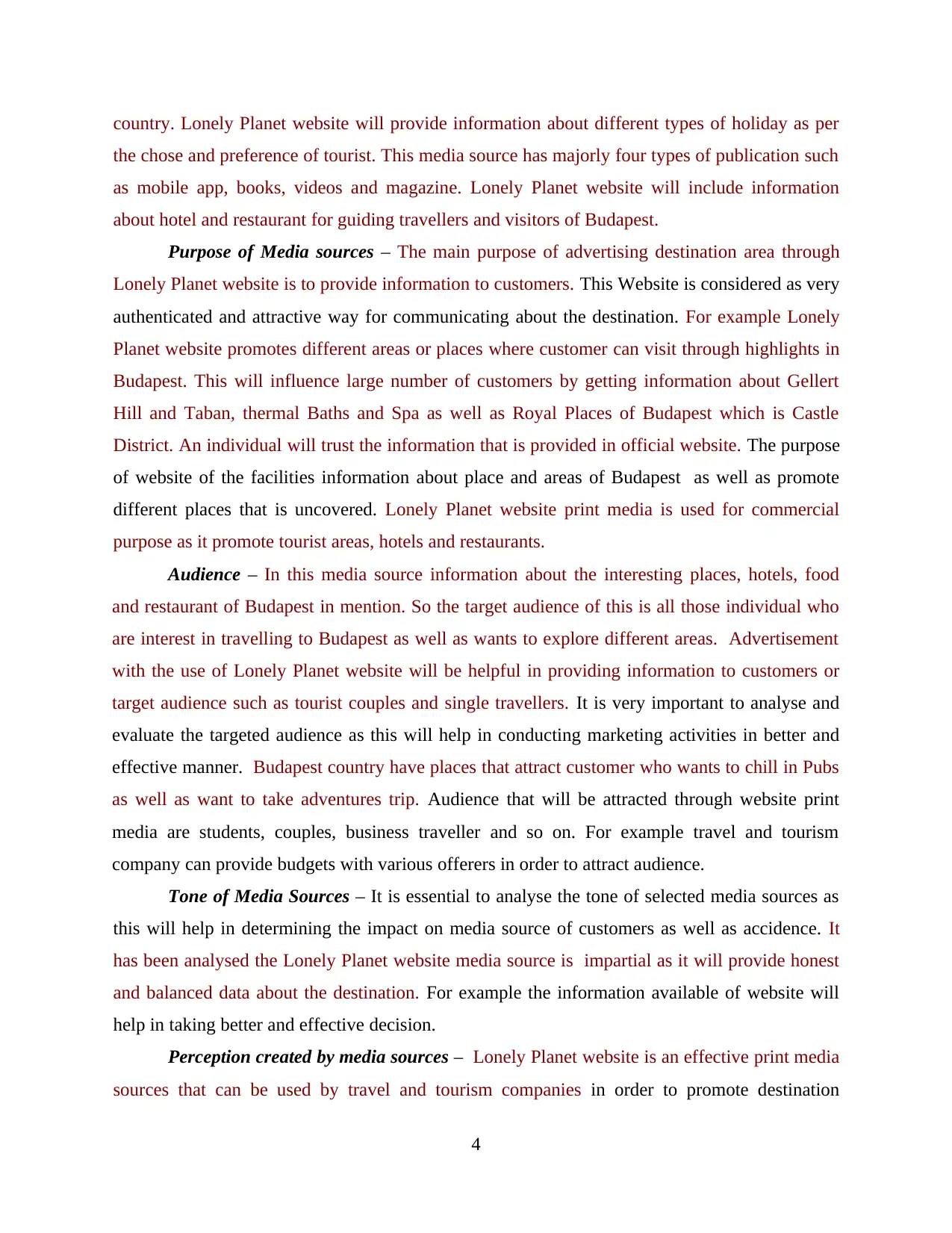
country. Lonely Planet website will provide information about different types of holiday as per
the chose and preference of tourist. This media source has majorly four types of publication such
as mobile app, books, videos and magazine. Lonely Planet website will include information
about hotel and restaurant for guiding travellers and visitors of Budapest.
Purpose of Media sources – The main purpose of advertising destination area through
Lonely Planet website is to provide information to customers. This Website is considered as very
authenticated and attractive way for communicating about the destination. For example Lonely
Planet website promotes different areas or places where customer can visit through highlights in
Budapest. This will influence large number of customers by getting information about Gellert
Hill and Taban, thermal Baths and Spa as well as Royal Places of Budapest which is Castle
District. An individual will trust the information that is provided in official website. The purpose
of website of the facilities information about place and areas of Budapest as well as promote
different places that is uncovered. Lonely Planet website print media is used for commercial
purpose as it promote tourist areas, hotels and restaurants.
Audience – In this media source information about the interesting places, hotels, food
and restaurant of Budapest in mention. So the target audience of this is all those individual who
are interest in travelling to Budapest as well as wants to explore different areas. Advertisement
with the use of Lonely Planet website will be helpful in providing information to customers or
target audience such as tourist couples and single travellers. It is very important to analyse and
evaluate the targeted audience as this will help in conducting marketing activities in better and
effective manner. Budapest country have places that attract customer who wants to chill in Pubs
as well as want to take adventures trip. Audience that will be attracted through website print
media are students, couples, business traveller and so on. For example travel and tourism
company can provide budgets with various offerers in order to attract audience.
Tone of Media Sources – It is essential to analyse the tone of selected media sources as
this will help in determining the impact on media source of customers as well as accidence. It
has been analysed the Lonely Planet website media source is impartial as it will provide honest
and balanced data about the destination. For example the information available of website will
help in taking better and effective decision.
Perception created by media sources – Lonely Planet website is an effective print media
sources that can be used by travel and tourism companies in order to promote destination
4
the chose and preference of tourist. This media source has majorly four types of publication such
as mobile app, books, videos and magazine. Lonely Planet website will include information
about hotel and restaurant for guiding travellers and visitors of Budapest.
Purpose of Media sources – The main purpose of advertising destination area through
Lonely Planet website is to provide information to customers. This Website is considered as very
authenticated and attractive way for communicating about the destination. For example Lonely
Planet website promotes different areas or places where customer can visit through highlights in
Budapest. This will influence large number of customers by getting information about Gellert
Hill and Taban, thermal Baths and Spa as well as Royal Places of Budapest which is Castle
District. An individual will trust the information that is provided in official website. The purpose
of website of the facilities information about place and areas of Budapest as well as promote
different places that is uncovered. Lonely Planet website print media is used for commercial
purpose as it promote tourist areas, hotels and restaurants.
Audience – In this media source information about the interesting places, hotels, food
and restaurant of Budapest in mention. So the target audience of this is all those individual who
are interest in travelling to Budapest as well as wants to explore different areas. Advertisement
with the use of Lonely Planet website will be helpful in providing information to customers or
target audience such as tourist couples and single travellers. It is very important to analyse and
evaluate the targeted audience as this will help in conducting marketing activities in better and
effective manner. Budapest country have places that attract customer who wants to chill in Pubs
as well as want to take adventures trip. Audience that will be attracted through website print
media are students, couples, business traveller and so on. For example travel and tourism
company can provide budgets with various offerers in order to attract audience.
Tone of Media Sources – It is essential to analyse the tone of selected media sources as
this will help in determining the impact on media source of customers as well as accidence. It
has been analysed the Lonely Planet website media source is impartial as it will provide honest
and balanced data about the destination. For example the information available of website will
help in taking better and effective decision.
Perception created by media sources – Lonely Planet website is an effective print media
sources that can be used by travel and tourism companies in order to promote destination
4
Paraphrase This Document
Need a fresh take? Get an instant paraphrase of this document with our AI Paraphraser
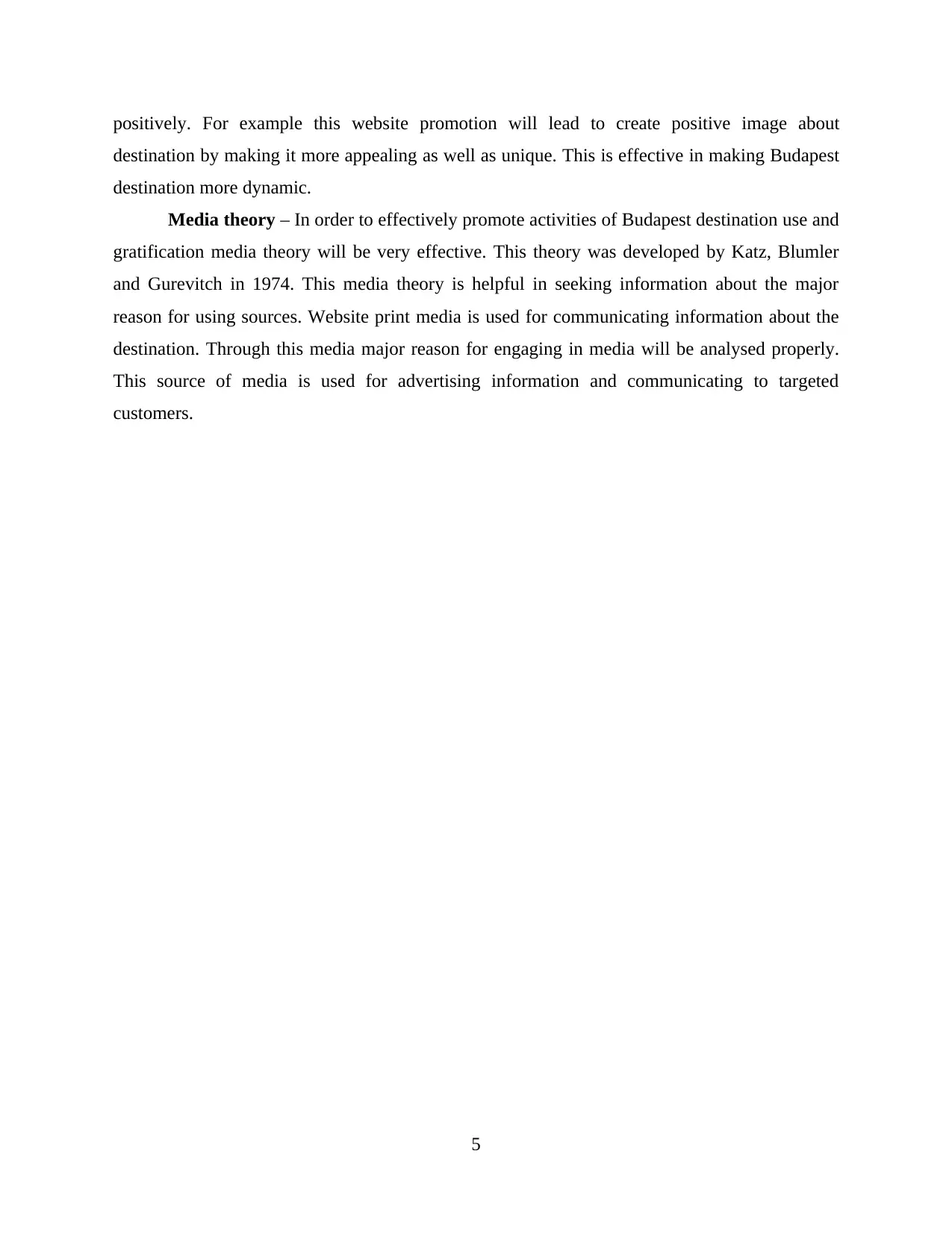
positively. For example this website promotion will lead to create positive image about
destination by making it more appealing as well as unique. This is effective in making Budapest
destination more dynamic.
Media theory – In order to effectively promote activities of Budapest destination use and
gratification media theory will be very effective. This theory was developed by Katz, Blumler
and Gurevitch in 1974. This media theory is helpful in seeking information about the major
reason for using sources. Website print media is used for communicating information about the
destination. Through this media major reason for engaging in media will be analysed properly.
This source of media is used for advertising information and communicating to targeted
customers.
5
destination by making it more appealing as well as unique. This is effective in making Budapest
destination more dynamic.
Media theory – In order to effectively promote activities of Budapest destination use and
gratification media theory will be very effective. This theory was developed by Katz, Blumler
and Gurevitch in 1974. This media theory is helpful in seeking information about the major
reason for using sources. Website print media is used for communicating information about the
destination. Through this media major reason for engaging in media will be analysed properly.
This source of media is used for advertising information and communicating to targeted
customers.
5
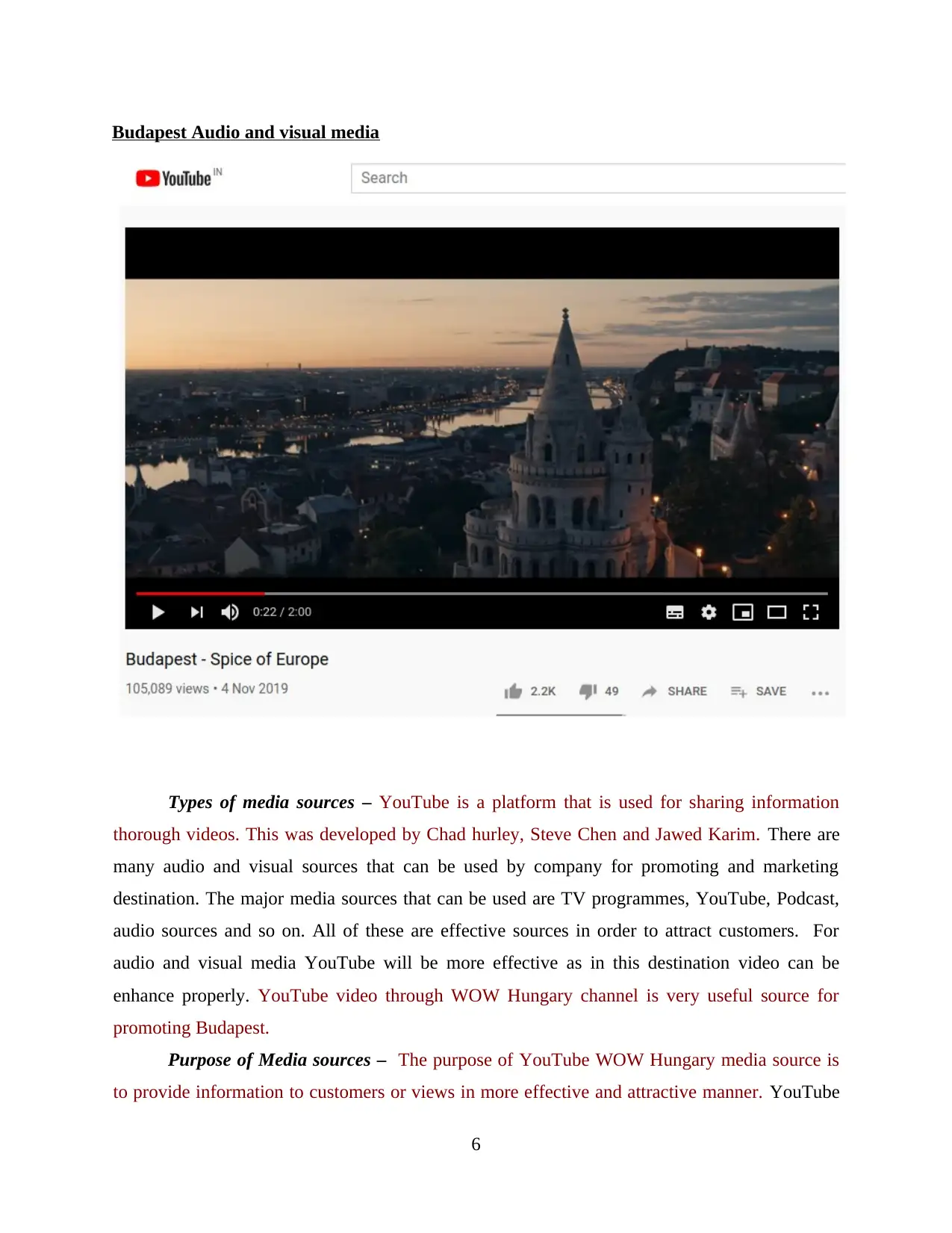
Budapest Audio and visual media
Types of media sources – YouTube is a platform that is used for sharing information
thorough videos. This was developed by Chad hurley, Steve Chen and Jawed Karim. There are
many audio and visual sources that can be used by company for promoting and marketing
destination. The major media sources that can be used are TV programmes, YouTube, Podcast,
audio sources and so on. All of these are effective sources in order to attract customers. For
audio and visual media YouTube will be more effective as in this destination video can be
enhance properly. YouTube video through WOW Hungary channel is very useful source for
promoting Budapest.
Purpose of Media sources – The purpose of YouTube WOW Hungary media source is
to provide information to customers or views in more effective and attractive manner. YouTube
6
Types of media sources – YouTube is a platform that is used for sharing information
thorough videos. This was developed by Chad hurley, Steve Chen and Jawed Karim. There are
many audio and visual sources that can be used by company for promoting and marketing
destination. The major media sources that can be used are TV programmes, YouTube, Podcast,
audio sources and so on. All of these are effective sources in order to attract customers. For
audio and visual media YouTube will be more effective as in this destination video can be
enhance properly. YouTube video through WOW Hungary channel is very useful source for
promoting Budapest.
Purpose of Media sources – The purpose of YouTube WOW Hungary media source is
to provide information to customers or views in more effective and attractive manner. YouTube
6
⊘ This is a preview!⊘
Do you want full access?
Subscribe today to unlock all pages.

Trusted by 1+ million students worldwide
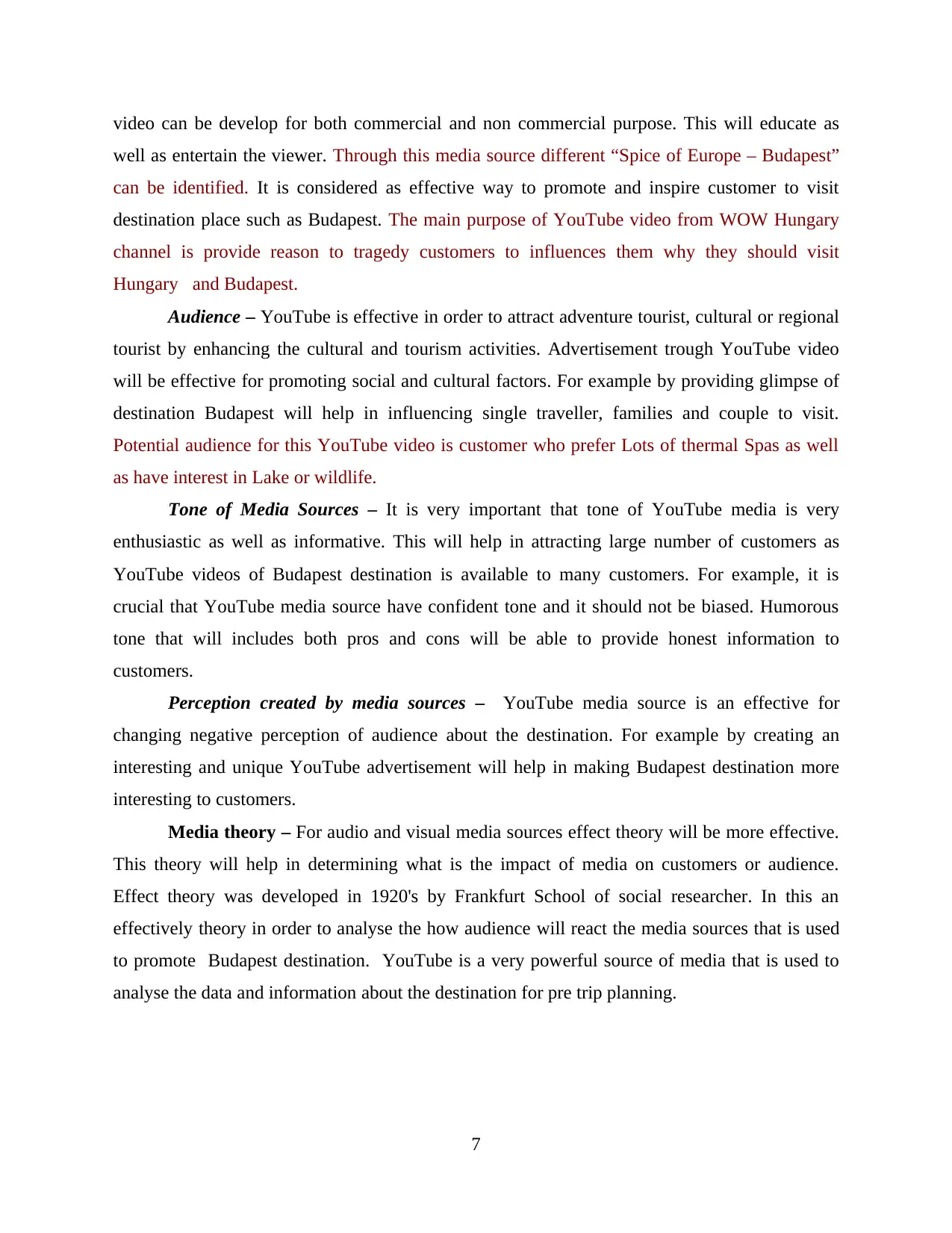
video can be develop for both commercial and non commercial purpose. This will educate as
well as entertain the viewer. Through this media source different “Spice of Europe – Budapest”
can be identified. It is considered as effective way to promote and inspire customer to visit
destination place such as Budapest. The main purpose of YouTube video from WOW Hungary
channel is provide reason to tragedy customers to influences them why they should visit
Hungary and Budapest.
Audience – YouTube is effective in order to attract adventure tourist, cultural or regional
tourist by enhancing the cultural and tourism activities. Advertisement trough YouTube video
will be effective for promoting social and cultural factors. For example by providing glimpse of
destination Budapest will help in influencing single traveller, families and couple to visit.
Potential audience for this YouTube video is customer who prefer Lots of thermal Spas as well
as have interest in Lake or wildlife.
Tone of Media Sources – It is very important that tone of YouTube media is very
enthusiastic as well as informative. This will help in attracting large number of customers as
YouTube videos of Budapest destination is available to many customers. For example, it is
crucial that YouTube media source have confident tone and it should not be biased. Humorous
tone that will includes both pros and cons will be able to provide honest information to
customers.
Perception created by media sources – YouTube media source is an effective for
changing negative perception of audience about the destination. For example by creating an
interesting and unique YouTube advertisement will help in making Budapest destination more
interesting to customers.
Media theory – For audio and visual media sources effect theory will be more effective.
This theory will help in determining what is the impact of media on customers or audience.
Effect theory was developed in 1920's by Frankfurt School of social researcher. In this an
effectively theory in order to analyse the how audience will react the media sources that is used
to promote Budapest destination. YouTube is a very powerful source of media that is used to
analyse the data and information about the destination for pre trip planning.
7
well as entertain the viewer. Through this media source different “Spice of Europe – Budapest”
can be identified. It is considered as effective way to promote and inspire customer to visit
destination place such as Budapest. The main purpose of YouTube video from WOW Hungary
channel is provide reason to tragedy customers to influences them why they should visit
Hungary and Budapest.
Audience – YouTube is effective in order to attract adventure tourist, cultural or regional
tourist by enhancing the cultural and tourism activities. Advertisement trough YouTube video
will be effective for promoting social and cultural factors. For example by providing glimpse of
destination Budapest will help in influencing single traveller, families and couple to visit.
Potential audience for this YouTube video is customer who prefer Lots of thermal Spas as well
as have interest in Lake or wildlife.
Tone of Media Sources – It is very important that tone of YouTube media is very
enthusiastic as well as informative. This will help in attracting large number of customers as
YouTube videos of Budapest destination is available to many customers. For example, it is
crucial that YouTube media source have confident tone and it should not be biased. Humorous
tone that will includes both pros and cons will be able to provide honest information to
customers.
Perception created by media sources – YouTube media source is an effective for
changing negative perception of audience about the destination. For example by creating an
interesting and unique YouTube advertisement will help in making Budapest destination more
interesting to customers.
Media theory – For audio and visual media sources effect theory will be more effective.
This theory will help in determining what is the impact of media on customers or audience.
Effect theory was developed in 1920's by Frankfurt School of social researcher. In this an
effectively theory in order to analyse the how audience will react the media sources that is used
to promote Budapest destination. YouTube is a very powerful source of media that is used to
analyse the data and information about the destination for pre trip planning.
7
Paraphrase This Document
Need a fresh take? Get an instant paraphrase of this document with our AI Paraphraser
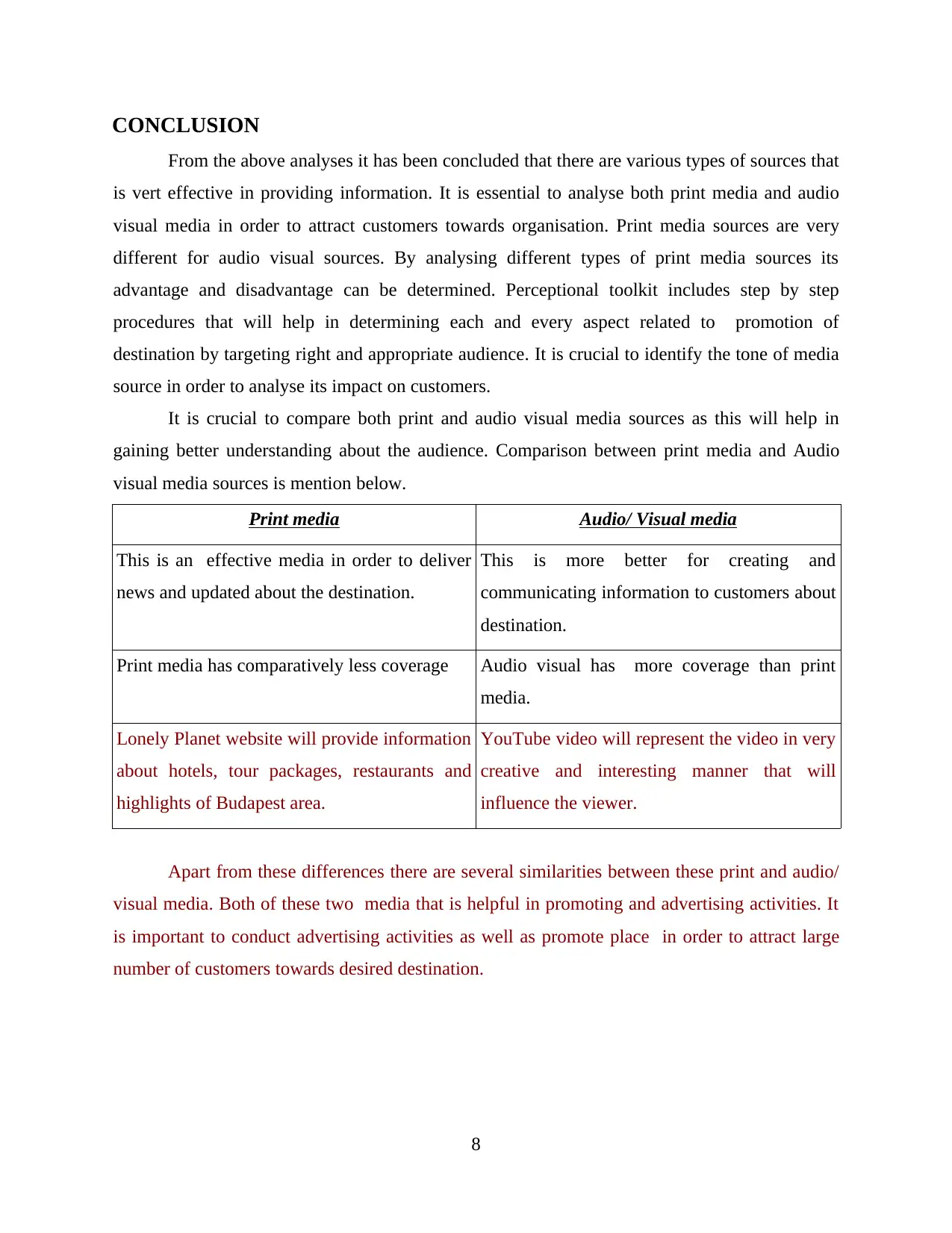
CONCLUSION
From the above analyses it has been concluded that there are various types of sources that
is vert effective in providing information. It is essential to analyse both print media and audio
visual media in order to attract customers towards organisation. Print media sources are very
different for audio visual sources. By analysing different types of print media sources its
advantage and disadvantage can be determined. Perceptional toolkit includes step by step
procedures that will help in determining each and every aspect related to promotion of
destination by targeting right and appropriate audience. It is crucial to identify the tone of media
source in order to analyse its impact on customers.
It is crucial to compare both print and audio visual media sources as this will help in
gaining better understanding about the audience. Comparison between print media and Audio
visual media sources is mention below.
Print media Audio/ Visual media
This is an effective media in order to deliver
news and updated about the destination.
This is more better for creating and
communicating information to customers about
destination.
Print media has comparatively less coverage Audio visual has more coverage than print
media.
Lonely Planet website will provide information
about hotels, tour packages, restaurants and
highlights of Budapest area.
YouTube video will represent the video in very
creative and interesting manner that will
influence the viewer.
Apart from these differences there are several similarities between these print and audio/
visual media. Both of these two media that is helpful in promoting and advertising activities. It
is important to conduct advertising activities as well as promote place in order to attract large
number of customers towards desired destination.
8
From the above analyses it has been concluded that there are various types of sources that
is vert effective in providing information. It is essential to analyse both print media and audio
visual media in order to attract customers towards organisation. Print media sources are very
different for audio visual sources. By analysing different types of print media sources its
advantage and disadvantage can be determined. Perceptional toolkit includes step by step
procedures that will help in determining each and every aspect related to promotion of
destination by targeting right and appropriate audience. It is crucial to identify the tone of media
source in order to analyse its impact on customers.
It is crucial to compare both print and audio visual media sources as this will help in
gaining better understanding about the audience. Comparison between print media and Audio
visual media sources is mention below.
Print media Audio/ Visual media
This is an effective media in order to deliver
news and updated about the destination.
This is more better for creating and
communicating information to customers about
destination.
Print media has comparatively less coverage Audio visual has more coverage than print
media.
Lonely Planet website will provide information
about hotels, tour packages, restaurants and
highlights of Budapest area.
YouTube video will represent the video in very
creative and interesting manner that will
influence the viewer.
Apart from these differences there are several similarities between these print and audio/
visual media. Both of these two media that is helpful in promoting and advertising activities. It
is important to conduct advertising activities as well as promote place in order to attract large
number of customers towards desired destination.
8
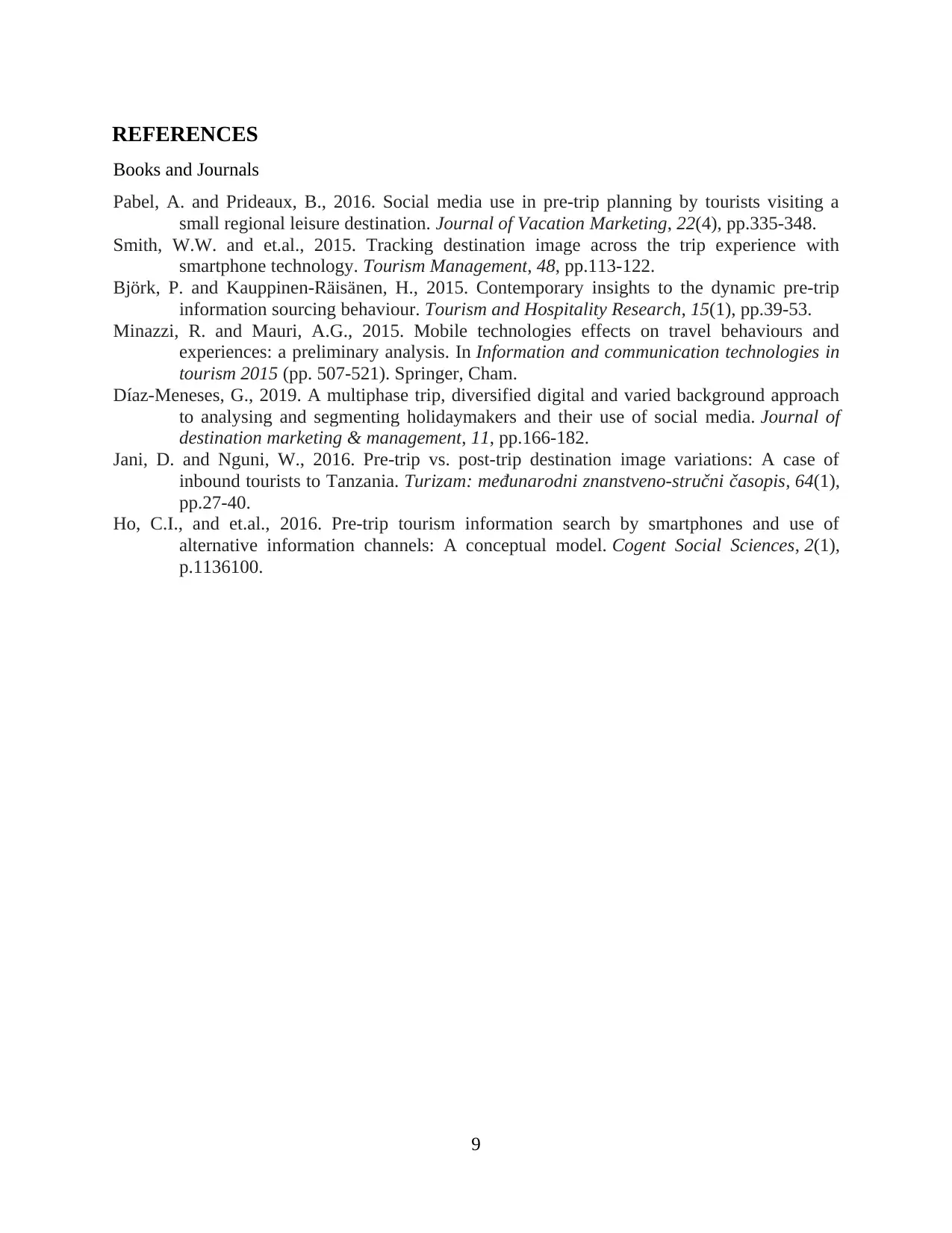
REFERENCES
Books and Journals
Pabel, A. and Prideaux, B., 2016. Social media use in pre-trip planning by tourists visiting a
small regional leisure destination. Journal of Vacation Marketing, 22(4), pp.335-348.
Smith, W.W. and et.al., 2015. Tracking destination image across the trip experience with
smartphone technology. Tourism Management, 48, pp.113-122.
Björk, P. and Kauppinen-Räisänen, H., 2015. Contemporary insights to the dynamic pre-trip
information sourcing behaviour. Tourism and Hospitality Research, 15(1), pp.39-53.
Minazzi, R. and Mauri, A.G., 2015. Mobile technologies effects on travel behaviours and
experiences: a preliminary analysis. In Information and communication technologies in
tourism 2015 (pp. 507-521). Springer, Cham.
Díaz-Meneses, G., 2019. A multiphase trip, diversified digital and varied background approach
to analysing and segmenting holidaymakers and their use of social media. Journal of
destination marketing & management, 11, pp.166-182.
Jani, D. and Nguni, W., 2016. Pre-trip vs. post-trip destination image variations: A case of
inbound tourists to Tanzania. Turizam: međunarodni znanstveno-stručni časopis, 64(1),
pp.27-40.
Ho, C.I., and et.al., 2016. Pre-trip tourism information search by smartphones and use of
alternative information channels: A conceptual model. Cogent Social Sciences, 2(1),
p.1136100.
9
Books and Journals
Pabel, A. and Prideaux, B., 2016. Social media use in pre-trip planning by tourists visiting a
small regional leisure destination. Journal of Vacation Marketing, 22(4), pp.335-348.
Smith, W.W. and et.al., 2015. Tracking destination image across the trip experience with
smartphone technology. Tourism Management, 48, pp.113-122.
Björk, P. and Kauppinen-Räisänen, H., 2015. Contemporary insights to the dynamic pre-trip
information sourcing behaviour. Tourism and Hospitality Research, 15(1), pp.39-53.
Minazzi, R. and Mauri, A.G., 2015. Mobile technologies effects on travel behaviours and
experiences: a preliminary analysis. In Information and communication technologies in
tourism 2015 (pp. 507-521). Springer, Cham.
Díaz-Meneses, G., 2019. A multiphase trip, diversified digital and varied background approach
to analysing and segmenting holidaymakers and their use of social media. Journal of
destination marketing & management, 11, pp.166-182.
Jani, D. and Nguni, W., 2016. Pre-trip vs. post-trip destination image variations: A case of
inbound tourists to Tanzania. Turizam: međunarodni znanstveno-stručni časopis, 64(1),
pp.27-40.
Ho, C.I., and et.al., 2016. Pre-trip tourism information search by smartphones and use of
alternative information channels: A conceptual model. Cogent Social Sciences, 2(1),
p.1136100.
9
⊘ This is a preview!⊘
Do you want full access?
Subscribe today to unlock all pages.

Trusted by 1+ million students worldwide
1 out of 9
Related Documents
Your All-in-One AI-Powered Toolkit for Academic Success.
+13062052269
info@desklib.com
Available 24*7 on WhatsApp / Email
![[object Object]](/_next/static/media/star-bottom.7253800d.svg)
Unlock your academic potential
Copyright © 2020–2025 A2Z Services. All Rights Reserved. Developed and managed by ZUCOL.





